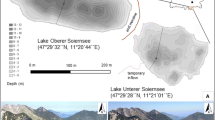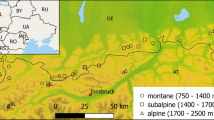Abstract
Microhabitat-level spatial variations in diatom and isotope compositions of epilithic periphyton in the littoral zones of Lake Malawi were examined using periphyton samples collected from seven regions of the lake. Discriminant analysis revealed a clear difference in diatom composition among the slopes of the rocks from which the samples were collected. This difference may be associated with interspecific variation in the adhesive power of diatoms. The slope of the rocks also strongly affected the stable carbon isotope ratios of periphyton, together with subsidiary effects of algae size class, sampling site, depth, and some of their interaction terms. The effect of slope can be explained by the decrease in photosynthetic activity along the slope, which originates from the decline in sunlight. Thus, the diatom composition and carbon isotope ratios may be good indicators of microhabitat and have the potential to be powerful tools for quantitative measurement of microhabitat utilization of epilithic algae-feeding consumers of this lake, including territorial cichlids.




Similar content being viewed by others
References
Abe, S., O. Katano, T. Nagumo & J. Tanaka, 2000. Grazing effects of ayu, Plecoglossus altivelis, on the species composition of benthic algal communities in the Kiso River. Diatom 16: 37–43.
Bearhop, S., C. E. Adams, S. Waldron, R. A. Fuller & H. Macleod, 2004. Determining trophic niche width: a novel approach using stable isotope analysis. Journal of Animal Ecology 73: 1007–1012.
Beauchamp, R. S. A., 1953. Hydrological data from Lake Nyasa. Journal of Ecology 41: 226–239.
Bootsma, H. A., R. E. Hecky, R. H. Hesslein & G. F. Turner, 1996. Food partitioning among Lake Malawi nearshore fishes as revealed by stable isotope analyses. Ecology 77: 1286–1290.
Cocquyt, C. & W. Vyverman, 1994. Composition and diversity of the algal flora in the East African Great Lakes: a comparative survey of lakes Tanganyika, Malawi (Nyasa) and Victoria. Archiv für Hydrobiologie-Beiheft Ergebnisse der Limnologie 44: 161–172.
DeNiro, M. J. & S. Epstein, 1978. Influence of diet on the distribution of carbon isotopes in animals. Geochimica et Cosmochimica Acta 42: 495–506.
DeNiro, M. J. & S. Epstein, 1981. Influence of diet on the distribution of nitrogen isotopes in animals. Geochimica et Cosmochimica Acta 45: 341351.
Dixit, S. S. & J. P. Smol, 2000. Sedimentary diatoms and chrysophytes as indicators of lakewater quality in North America. In Martin, R. E. (ed.), Environmental Micropaleontology. Topics in Geobiology, Vol. 15. Kluwer Academic/Plenum Publishers, New York: 279–303.
Genner, M. J., G. F. Turner, S. Barker & S. J. Hawkins, 1999a. Niche segregation among Lake Malawi cichlid fishes? Evidence from stable isotope signatures. Ecology Letters 2: 185–190.
Genner, M. J., G. F. Turner & S. J. Hawkins, 1999b. Foraging of rocky habitat cichlid fishes in Lake Malawi: coexistence through niche partitioning? Oecologia 121: 283–292.
Hesslein, R. H., 1993. Replacement of sulfur, carbon, and nitrogen in tissue of growing broad whitefish (Coregonus nasus) in response to a change in diet traced by δ34S, δ13C, and δ15N. Canadian Journal of Fisheries and Aquatic Sciences 50: 2071–2076.
Higgins, S. N., H. J. Kling, R. E. Hecky, W. D. Taylor & H. A. Bootsma, 2003a. The community composition, distribution, and nutrient status of epilithic periphyton at five rocky littoral zone sites in Lake Malawi, Africa. Journal of Great Lakes Research 29: 181–189.
Higgins, M. J., P. Molino, P. Mulvaney & R. Wetherbee, 2003b. The structure and nanomechanical properties of the adhesive mucilage that mediates diatom-substratum adhesion and motility. Journal of Phycology 39: 1181–1193.
Hill, W. R. & R. G. Middleton, 2006. Changes in carbon stable isotope ratios during periphyton development. Limnology and Oceanography 51: 2360–2369.
Hobson, K. A., 1999. Tracing origins and migration of wildlife using stable isotopes: a review. Oecologia 120: 314–326.
Hubbell, S. P., 2001. The unified neutral theory of biodiversity and biogeography, Vol. 32. Princeton University Press, Princeton.
Julliard, R., J. Clavel, V. Devictor, F. Jiguet & D. Couvet, 2006. Spatial segregation of specialists and generalists in bird communities. Ecology letters 9: 1237–1244.
Klee, R. & S. J. Casper, 1992. New centric diatoms (Thalassiosirales) of Lake Malawi (formerly Lake Nyassa; Malawi, East Africa). Archiv Fur Protistenkunde 142: 179–192.
Klee, R. & S. J. Casper, 1995. Stephanodiscus nyassae Klee et Casper nov. spec., a new centric diatom (Thalassiosirales) from Lake Malawi (Malawi, East Africa). Archiv Fur Protistenkunde 146: 293–297.
Krammer, K. & H. Lange-bertalot, 1988. Bacillariophyceae. In Ettl, H., J. Gerloff, H. Heining & D. Mollrnhauser (eds), Süßwasserflora von Mitteleuropa: Band 2/2 G. Fischer, Stuttgart: 1–536.
Lange-Bertalot, H., 2001. Navicula sensu stricto, 10 genera separated from Navicula sensu lato, Frustulia. In Lange-Bertalot, H. (ed.), Diatoms of Europe 2. A. R. G. Gantner, Ruggell: 1–526.
Levine, J. M. & J. HilleRisLambers, 2009. The importance of niches for the maintenance of species diversity. Nature 461: 254–257.
MacLeod, N. A. & D. R. Barton, 1998. Effects of light intensity, water velocity, and species composition on carbon and nitrogen stable isotope ratios in periphyton. Canadian Journal of Fisheries and Aquatic Sciences 55: 1919–1925.
Marks, J. C. & R. L. Lowe, 1993. Interactive effects of nutrient availability and light levels on the periphyton composition of a large oligotrophic lake. Canadian Journal of Fisheries and Aquatic Sciences 50(6): 1270–1278.
Marsh, A. C. & A. J. Ribbink, 1985. Feeding site utilization in three sympatric species of Petrotilapia (Pisces: Cichlidae) from L. Malawi. Biological Journal of Linnean Society 25: 331–338.
Maruyama, A., Y. Yamada, B. Rusuwa & M. Yuma, 2001. Change in stable nitrogen isotope ratio in the muscle tissue of a migratory goby, Rhinogobius sp., in a natural setting. Canadian Journal of Fisheries and Aquatic Sciences 58: 2125–2128.
May, R. M., 1973. Stability and Complexity in Model Ecosystems. Princeton University Press, Princeton.
Müller, O., 1903. Bacillariaceen aus dem Nyassalande und einigen benachbarten Gebieten. Erste Folge. Surirelloidae-Surirelleae. Botanische Jahrbücher fur Systematik, Pflanzengeschichte und Pflanzengeographie 34: 9–38.
Müller, O., 1904. Bacillariaceen aus dem Nyassalande und einigen benachbarten Gebieten. Zweite Folge Discoidae-Coscinodisceae. Discoidae-Eupodisceae. Botanische Jahrbücher fur Systematik, Pflanzengeschichte und Pflanzengeographie 34: 255–301.
Müller, O., 1905. Bacillariaceen aus dem Nyassalande und einigen benachbarten Gebieten. Dritte Folge Discoidae-Coscinodisceae. Discoidae-Eupodisceae. Botanische Jahrbücher fur Systematik, Pflanzengeschichte und Pflanzengeographie 34: 138–205.
Müller, O., 1910. Bacillariaceen aus dem Nyassalande und einigen benachbarten Gebieten. Vierte Folge Naviculoideae-Naviculeae-Naviculinae. Fragilarioideae-Fragilarieae-Fragilarinae. Fragilarioideae-Fragilarieae-Eunotiinae. Botanische Jahrbücher fur Systematik, Pflanzengeschichte und Pflanzengeographie 45: 69–122.
Reinthal, P. N., 1990. The feeding habits of a group of herbivorous rock-dwelling cichlid fishes (Cichlidae: Perciformes) from Lake Malawi, Africa. Environmental Biology of Fishes 27: 215–233.
Ribbink, A. J., B. A. Marsh, A. C. Marsh, A. C. Ribbink & B. J. Sharp, 1983. A preliminary survey of the cichlid fishes of rocky habitats in Lake Malawi. South African Journal of Zoology 18: 149–310.
Rutz, C., L. A. Bluff, N. Reed, J. Troscianko, J. Newton, R. Inger, A. Kacelnik & S. Bearhop, 2010. The ecological significance of tool use in New Caledonian crows. Science 329: 1523–1526.
Schmidt, A., M. Schmidt, F. Fricke, H. Heiden, O. Müller & F. Hustedt, 1874–1959. Atlas der Diatomaceen–kunde. Leipzig, Aschersleben.
Shinohara, K., A. Maruyama, B. Rusuwa & T. Ohtsuka, 2014. Taxonomic revision of three diatoms found in Lake Malawi: Afrocymbella brunii (Fricke) comb. nov., Afrocymbella rossii (Kociolek & Stoermer) comb. nov., and Aulacoseira euareolata (O.Müller) comb. nov. et nom. nov. Phycological Research 62: 9–15.
Stoermer, E. F. & J. P. Smol, 1999. The diatoms: applications for the environmental and earth sciences. Cambridge University Press, Cambridge.
Turner, G. F., O. Seehausen, M. E. Knight, C. J. Allender & R. Robinson, 2001. How many species of cichlid fishes are there in African lakes? Molecular Ecology 10: 793–806.
Acknowledgments
We are grateful to Mr R. Zatha, Mr Y. Kazembe, Mr B. Matundu, Mr A. Nyoni, and Mr A. Mangawa at the University of Malawi for their support during sample collection. We also thank Ms Y. Nonomatsu, Ms M. Umemoto, Mr Y. Nakamura, and Ms E. Ishizumi for their assistance with laboratory analyses. Our thanks go to Dr M. Yuma, Dr M. Genner, and anonymous reviewers for their constructive criticism. This study was conducted in accordance with the prevailing laws of the Republic of Malawi. Financial support was provided by the Joint Research Centre for Science and Technology of Ryukoku University and by JSPS KAKENHI Grant Number 25840144.
Author information
Authors and Affiliations
Corresponding author
Additional information
Atsushi Maruyama and Kohei Shinohara contributed equally to this work.
Guest editors: S. Koblmüller, R. C. Albertson, M. J. Genner, K. M. Sefc & T. Takahashi / Advances in Cichlid Research: Behavior, Ecology and Evolutionary Biology
Electronic supplementary material
Below is the link to the electronic supplementary material.
Rights and permissions
About this article
Cite this article
Maruyama, A., Shinohara, K., Sakurai, M. et al. Microhabitat variations in diatom composition and stable isotope ratios of the epilithic algae in Lake Malawi. Hydrobiologia 748, 161–169 (2015). https://doi.org/10.1007/s10750-014-1977-3
Received:
Accepted:
Published:
Issue Date:
DOI: https://doi.org/10.1007/s10750-014-1977-3




